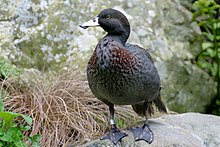Blue duck
| Blue duck | |
|---|---|
 |
|
| Blue duck at Staglands, Akatarawa Valley | |
| Scientific classification | |
| Kingdom: | Animalia |
| Phylum: | Chordata |
| Class: | Aves |
| Order: | Anseriformes |
| Family: | Anatidae |
| Subfamily: | Tadorninae |
| Genus: |
Hymenolaimus G.R. Gray, 1843 |
| Species: | H. malacorhynchos |
| Binomial name | |
|
Hymenolaimus malacorhynchos (Gmelin, 1789) |
|
| Subspecies | |
|
|
The blue duck (Hymenolaimus malacorhynchos) is a member of the duck, goose and swan family Anatidae endemic to New Zealand. It is the only member of the genus Hymenolaimus, placed in the shelduck subfamily Tadorninae after previously being considered part of the paraphyletic "perching duck" assemblage. The Māori name, sometimes used in English, is whio (pronounced "fee-oh"), which is an onomatopoetic rendition of the males' call.
The blue duck is depicted on the reverse side of the New Zealand $10 banknote.
The blue duck is a dark slate-grey with a chestnut-flecked breast and a paler bill and eye. The pinkish-white bill has fleshy flaps of skin hanging from the sides of its tip. The male's call is an aspirated whistle, and the female's is a rattling growl. The blue duck hatches with a green beak for just 8 hours after hatching; after which it then develops its final colour.
The blue duck is unlike any other duck. It is the only member of its genus and has no close relatives. First described by Gmelin in 1789. Its taxonomic relationships with other waterfowl species are uncertain; DNA analysis has placed it as a sister to the South American dabbling ducks (Anatini), but with no close relative. The blue duck was formerly thought to be related to the shelduck tribe.
Although the North Island and South Island whio are genetically distinct, they are not described as sub-species; they are, however, treated as separate management units.
This species is an endemic resident breeder in New Zealand, nesting in hollow logs, small caves and other sheltered spots. It is a rare duck, holding territories on fast flowing mountain rivers. It is a powerful swimmer even in strong currents, but is reluctant to fly. It is difficult to find, but not particularly wary when located.
...
Wikipedia

